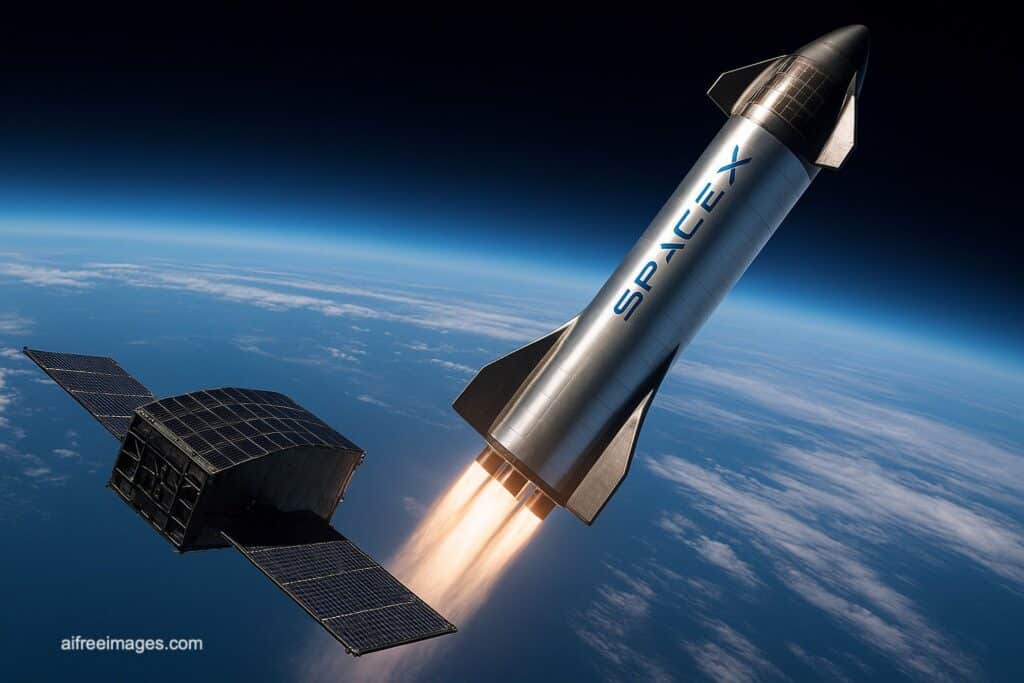SpaceX redefines satellite communications performance with the next-generation Starlink V3, optimizing speed, latency, and orbital efficiency through laser links and low-Earth orbit design
The Starlink V3 constellation represents a significant advancement in low Earth orbit (LEO) satellite network design. Combining improvements in orbital altitude, inter-satellite laser links, enhanced onboard processing capacity, and a redesigned ground segment (teleports), SpaceX aims to reduce latency to as low as 5 milliseconds and deliver download speeds of up to 1 Tbps per satellite.
Latency in Satellite Networks: Physical Fundamentals
Satellite connection latency is primarily determined by the distance data must travel, the number of routing hops, and the transmission medium. In Starlink V3:
- Orbital altitude: The new satellites will operate at 350 km, compared to 550 km for V2, cutting the propagation delay from ~3.7 ms (V2) to ~2.3 ms (V3) per one-way trip.
- LEO vs. GEO: Traditional GEO satellites (~35,786 km) have latencies exceeding 500 ms. Starlink’s LEO architecture allows for latencies under 20 ms in optimal conditions, with V3 aiming for even less.
How Starlink V3 Could Achieve 5 ms Latency
The 5 ms figure mentioned by Elon Musk refers to ideal test conditions—such as direct satellite-to-satellite laser transmission and proximity to a ground teleport. Several factors contribute:
- Lower orbital altitude: Reduces propagation delay.
- Inter-satellite laser links (ISLs): Enable direct data hopping between satellites, bypassing Earth-based routing to cut latency.
- Fewer physical hops: Traditional networks require many terrestrial routers. Starlink can route data: user → satellite → satellite → teleport → Internet backbone.
- Vacuum transmission: Laser signals in space travel faster than fiber optics—up to 40% faster than light in silica.
- Teleport placement and peering optimization: A distributed array of ground gateways minimizes total round-trip time to internet exchanges.
In real-world use, residential customers may experience 20–30 ms average latency, with minimums potentially near 10–15 ms in well-connected regions. Scenarios like airborne-to-airborne communication could approach the 5 ms benchmark.
Transmission Speeds and Throughput
Each Starlink V3 satellite can deliver up to 1 Tbps download capacity, a 10x increase over the estimated ~100 Gbps of V2 Mini. Upload bandwidth is even more improved: up to 160 Gbps, or 24x the previous generation.
This performance is achieved through:
- Advanced spatial and spectral multiplexing techniques.
- High-performance onboard network processors, capable of managing large traffic volumes with QoS.
- Upgraded user terminal phased-array antennas, offering wider simultaneous bandwidth per beam.
Ground Segment and Teleport Infrastructure
Teleports (ground gateways) are critical to bridging satellites with the terrestrial internet. Actual throughput and latency depend on:
- User proximity to the teleport: The closer, the lower the RTT.
- Teleport backhaul and peering: High-capacity connections to Tier-1 networks or IXPs are crucial.
- Multi-zone redundancy: If one teleport fails or saturates, laser links reroute traffic through other nodes—enhancing reliability.
Starlink V3 plans include building new teleport sites in key regions and integrating mobile gateway platforms on ships and movable bases.
Conclusion: The Most Ambitious and Technically Sophisticated LEO Network
Starlink V3 is not a mere upgrade—it’s a leap toward a software-defined space network, capable of rivaling fiber in speed and latency. Laser interlinks, low orbits, and direct inter-satellite routing overcome the historical limits of satellite connectivity.
If SpaceX meets its deployment goals—with up to 5,000 satellites launched per year using Starship 3—Starlink V3 could become the global backbone for mission-critical applications, edge computing, connected mobility, and ultra-low latency services like gaming and real-time collaboration, even in remote or rural locations.
With its unprecedented mix of speed, latency, and scalability, Starlink V3 is shaping up to be one of the most disruptive network infrastructures in the modern world.
Sources: Notebook check and Redes Sociales

